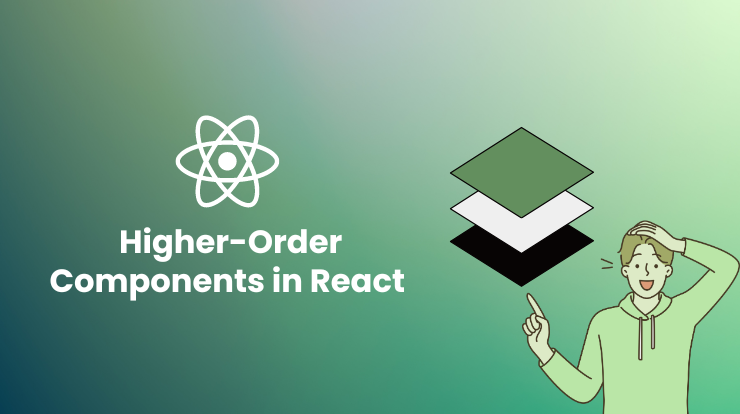React, is a JavaScript library for building user interfaces. It gained immense popularity for its declarative and component-based approach. One of the powerful concepts within React is the Higher Order Components (HOC).
In this blog post, we’ll delve into the world of higher-order components, exploring their definition, use cases, and how they contribute to a more modular and scalable React application.
Understanding Higher Order Components
A Higher Order Component (HOC) is a function that takes a component and returns a new enhanced component. It enables component reusability, abstraction of logic, and augmentation of features.
By wrapping a component with an HOC, you can augment its behavior, add additional props, or apply certain functionalities.
This pattern promotes code reusability and maintainability by isolating common logic in separate functions, making it easier to manage and update shared functionalities across multiple components.
HOCs are widely used in React development to streamline the implementation of cross-cutting concerns such as logging, authentication, or data fetching.
See the following simple example of higher order components in react.
// HOC Example
const withLogger = (WrappedComponent) => {
class WithLogger extends React.Component {
componentDidMount() {
console.log(`Component ${WrappedComponent.name} is mounted`);
}
render() {
return <WrappedComponent {...this.props} />;
}
}
return WithLogger;
};
// Usage
const EnhancedComponent = withLogger(MyComponent);In this example, the withLogger HOC adds a componentDidMount method to log when the wrapped component is mounted. This simple illustration showcases the power of HOCs in enhancing and extending components.
Use Cases of Higher Order Components
Now that we have got an understanding of HOCs, let’s explore some common use cases where HOCs can significantly improve the structure and maintainability of your React application.
Code Reusability
Higher order components are basically used in promoting code reusability of the React component. Imagine you have a set of utility functions or behaviors that need to be shared across multiple components.
Instead of duplicating the same code in each component, an HOC can encapsulate that logic, making it easily reuseable and maintainable.
Let’s see the example of example of authentication scenario because authentication is a common functionality and we can wrap it in one component as an HOC.
const withAuthentication = (WrappedComponent) => {
// Authentication logic here
// ...
return (props) => (
<WrappedComponent {...props} />
);
};Also Read: Add Sign in with Google Button in React Application
Conditional Rendering
You can also utilize the higher-order component in conditionally rendered components based on certain conditions.
For example, a withAuthorization HOC might render a component only if the user is authenticated.
const withAuthorization = (WrappedComponent) => {
return class WithAuthorization extends React.Component {
render() {
if (this.props.isAuthenticated) {
return <WrappedComponent {...this.props} />;
} else {
return <UnauthorizedAccess />;
}
}
};
};State Management
HOCs can be used to manage stateful logic that doesn’t necessarily belong to a specific component. This separation of concerns enhances code organization and readability.
See the following code example of state management with HOC in React.
const withToggle = (WrappedComponent) => {
return class WithToggle extends React.Component {
constructor(props) {
super(props);
this.state = {
isOpen: false,
};
}
toggle = () => {
this.setState((prevState) => ({ isOpen: !prevState.isOpen }));
};
render() {
return (
<WrappedComponent
{...this.props}
isOpen={this.state.isOpen}
toggle={this.toggle}
/>
);
}
};
};Pros and Cons of Higher Order Components
As with any technology or design pattern, it’s essential to have the advantages and disadvantages. Let’s explore the pros and cons of using higher-order components in React applications.
Pros
Reusability and Composability:
HOCs promote the reuse of logic across different components, leading to a more modular and maintainable codebase. Composability is enhanced as HOCs can be combined to create complex components.
Separation of Concerns:
By abstracting common functionalities into HOCs, the concerns of each component become more focused. This separation makes code easier to understand and maintain.
Enhanced Testing:
By using the HOCs, it is easier for unit testing because it encapsulates the logic in separate components and you can test that component independently. This improves the overall testability of your application.
Cons
Prop Drilling:
Higher-order components may lead to prop drilling, where props have to be passed through multiple levels of React components. This can make the component tree more complex and decrease code readability.
Understanding Curve:
For developers new to React, understanding and debugging HOCs might be a challenge. The abstraction they introduce can sometimes make it harder to follow the flow of data and logic.
Name Clashes:
As HOCs wrap components, naming clashes may occur. It’s crucial to adopt a consistent naming convention to make fewer potential conflicts.
Best Practices for Using Higher Order Components
To check the power of HOCs effectively, developers should adhere to certain best practices. Let’s explore these guidelines to ensure a smooth and maintainable React application.
Clear Naming Conventions
Adopt clear and descriptive names for your HOCs. This helps in understanding their purpose and avoids naming conflicts in large codebases.
// Good Naming const withAuthentication = /* ... */; // Avoid Ambiguity const enhance = /* ... */;
Document Your HOCs
Provide documentation for your HOCs, explaining their purpose, expected props, and usage. This documentation becomes invaluable when collaborating with other developers or revisiting code after a period.
/**
* HOC to add authentication functionality to a component.
* @param {React.ComponentType} WrappedComponent - The component to be wrapped.
* @returns {React.ComponentType} - The enhanced component.
*/
const withAuthentication = /* ... */;Avoid Mutating Wrapped Components
Ensure that your HOCs do not mutate the properties or state of the wrapped components. This helps in maintaining the integrity of the original components.
const withLogger = (WrappedComponent) => {
// Incorrect: Mutating state directly
WrappedComponent.prototype.componentDidMount = () => {
this.setState({ isMounted: true });
};
// Correct: No mutation
class WithLogger extends React.Component {
// ...
}
return WithLogger;
};Complete HOC Example Using React Functional Component
// withLogger.js
import React, { useEffect } from 'react';
// Higher Order Component
const withLogger = (WrappedComponent) => {
return function WithLogger(props) {
useEffect(() => {
console.log(`Component ${WrappedComponent.name || 'Anonymous'} is mounted`);
return () => {
console.log(`Component ${WrappedComponent.name || 'Anonymous'} is unmounted`);
};
}, []);
return <WrappedComponent {...props} />;
};
};
export default withLogger;// MyComponent.js
import React from 'react';
// My Component
const MyComponent = () => {
return <div>Hello, World!</div>;
};
export default MyComponent;// App.js
import React from 'react';
import MyComponent from './Components/MyComponent';
import withLogger from './HOC/withLogger';
// Using the Higher Order Component
const MyComponentWithLogger = withLogger(MyComponent);
// App component
const App = () => {
return (
<div>
<MyComponentWithLogger />
</div>
);
};
export default App;Related Links
Conclusion
In conclusion, higher-order components in React provide a powerful mechanism for code reuse, logic abstraction, and component enhancement.
When employed thoughtfully, Higher Order Components (HOCs) can play a crucial role in enhancing the maintainability and scalability of React applications.
As with any feature or pattern, it’s essential to weigh the pros and cons, understand best practices, and consider alternative solutions like Render Props or Hooks.
By mastering the art of Higher Order Components, you unlock a versatile feature in your React application.
FAQs
A Higher Order Component (HOC) in React is a function that takes a component and returns a new enhanced component. It’s a feature that is used to promote code reusability, abstraction of logic, and augmentation of features by encapsulating common functionalities.
Higher-order components enhance code reusability by allowing the encapsulation of shared logic in a single function. This logic can then be applied across different components, eliminating the need for duplicating code and ensuring a more modular and maintainable codebase.
Common use cases for higher-order components include code reusability, conditional rendering based on certain criteria (e.g., authentication status), and state management. HOCs provide a versatile solution for extracting and sharing functionalities across various parts of a React application.
The advantages of using higher-order components include enhanced reusability and composability, separation of concerns leading to clearer code organization, and improved testing capabilities. HOCs provide a structured way to abstract and share functionalities, contributing to a more efficient development process.
While higher-order components offer numerous benefits, they come with some downsides. Potential issues include prop drilling, where props need to be passed through multiple levels of components.







